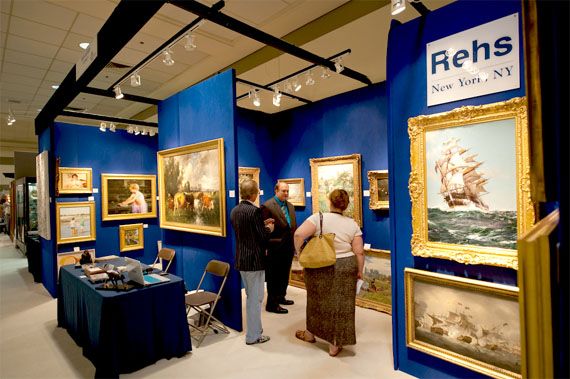
Photo Credit: Mark Lovett & Adriano Castelli
I was asked to comment on this topic almost two years ago and have been thinking about it ever since. Bob, the individual who posed the topic, is a very good friend and client of ours.
After seeing us at a show he sent an email asking the following: How do people who go to shows know who to trust? How can someone really believe that what a dealer is telling them is, in fact, the truth? Does someone actually walk into a show and just buy what they see? How does someone do their due diligence?
 Before I get to the questions, let’s quickly cover "a show." Large Art and/or Antique shows are, at this point, one of the main games in town and they have their pluses and minuses. Their most positive aspects are: they create a central location where dealers can meet thousands of people in the span of just three or four days and visitors can see and compare the offerings of a number of dealers in one location.
Before I get to the questions, let’s quickly cover "a show." Large Art and/or Antique shows are, at this point, one of the main games in town and they have their pluses and minuses. Their most positive aspects are: they create a central location where dealers can meet thousands of people in the span of just three or four days and visitors can see and compare the offerings of a number of dealers in one location.
Their main negatives are: only a selection of a dealer’s inventory will be displayed, they last for only a few days and, most importantly, some shows can give credibility to dealers who do not deserve it. So, you decide to visit a show...now what?
First, it is important to understand that shows come in all shapes and sizes. Some cater to the top level dealers and normally the works shown will be more expensive; however, there is usually a good reason for that. Typically (but not always) these works are the cream of the crop - those done during the prime period of an artist, in great condition and of superb quality. Others shows cater to a wider range of dealers and the items on display can range from the very expensive to the easily affordable. Finally, there are low end shows (more like flea markets) where you have to dig through items stacked one in front, or on top, of another (which can be fun and often a little dusty).
For our purposes, let’s stick to the middle and high level shows. For the visitor, the best part of a show is that you get a chance to meet the dealers and ask questions; remember that there are no ‘dumb’ questions – well, I do have a list of about 30 questions and comments that would fall into the ‘dumb/annoying’ category (see some of my previous articles).
 This is your opportunity to start building personal relationships with those dealers you feel know what they are doing. If you are lucky enough to live in an area that supports these shows, and you are interested in buying art and antiques, I would suggest that you attend. These shows will also give you a chance to see how different dealers present their works and how a particular piece stacks up against the other works in the dealer’s booth, or against a competitor’s work – which can often be very enlightening.
This is your opportunity to start building personal relationships with those dealers you feel know what they are doing. If you are lucky enough to live in an area that supports these shows, and you are interested in buying art and antiques, I would suggest that you attend. These shows will also give you a chance to see how different dealers present their works and how a particular piece stacks up against the other works in the dealer’s booth, or against a competitor’s work – which can often be very enlightening.
While walking the show floor, the first thing you will notice is a dealer’s overall presentation. If a booth looks pretty sloppy (no order to the hanging, broken frames, unrestored works, etc.) you generally find the works to be a mixed bag - many of which fall into the ‘decorative’ category. When I see booths like that, my first thought is that the dealer is more of a merchant and not a real expert. Now, that is not to say you cannot find a gem buried somewhere, or that the dealer does not 'know their stuff,' but normally the first impression is the right one.
I believe that dealers who present a clean, neat, space with an attractive arrangement tend to appreciate the works they are offering and typically have more knowledge about them. In addition, the works should be properly labeled with the artist’s name, title, size, etc. and if the prices are not posted, then a list should be easily accessible, not hidden in a draw or in the dealer’s pocket. You want to be sure that the price you are being quoted is the same other people are.
 Here is a great story about pricing. I was standing in a dealer’s booth at a show talking to the owner. There was a painting hanging near us that I know was priced at $500,000 (I had seen it at a number of other shows). While standing in the booth (on the last day of the show) a woman walked in and one of the salesmen started talking to her.
Here is a great story about pricing. I was standing in a dealer’s booth at a show talking to the owner. There was a painting hanging near us that I know was priced at $500,000 (I had seen it at a number of other shows). While standing in the booth (on the last day of the show) a woman walked in and one of the salesmen started talking to her.
At some point in the conversation he said the following: “...the painting is priced at $600,000, but it is the last day of the show and I would really like to make a deal, so I will offer it to you for $400,000." WOW, he just raised the price 20% and then cut it by 33.3%; I was shocked and wondered if that would really work? I walked back to my booth and watched the woman talk to the salesman for another 10 or 15 minutes; I am pleased to report that she finally walked out – without the painting. Now I know there are different sales techniques, but that one seemed a little devious to me. The sad thing is that I know people do fall for that sales technique.
Now let’s get back to Bob’s questions, one of which was: Does someone actually walk into a show and just buy what they see? Over my 30 years I have found that there are various types of the people attending shows; for my discussion, I will stick to the three main groups. The first are your veterans, or seasoned buyers - these people know what they are looking at, have a fairly good understanding of the market and just need some of the facts about a particular work in order to make a decision. These buyers can often make a decision on the spot, and many do. Hey, I know this might sound strange but one of the main reasons us dealers do shows is to make sales!
 Then we have the lightly seasoned buyer - people who might have bought an inexpensive work before, but have yet to take the big plunge. If these people have done the right prep work - determined the periods of art they like, visited local museums and galleries, and searched the internet to read up on the dealers who will be exhibiting - then they can come to a show and actually buy something; but typically they spend a great deal of time roaming the show and comparing pieces from different dealers. It usually takes two or three shows before they get comfortable with making a decision on the spot.
Then we have the lightly seasoned buyer - people who might have bought an inexpensive work before, but have yet to take the big plunge. If these people have done the right prep work - determined the periods of art they like, visited local museums and galleries, and searched the internet to read up on the dealers who will be exhibiting - then they can come to a show and actually buy something; but typically they spend a great deal of time roaming the show and comparing pieces from different dealers. It usually takes two or three shows before they get comfortable with making a decision on the spot.
Finally there is the unseasoned buyer or newbie - people who have no idea what they are doing and come to a show just to look and maybe buy something if it strikes their fancy. Over the years I have seen many people like this and at times, they end up with a very bad experience. Here is an example: I was at a recent show and watched a couple wander the floor for a few hours; you could tell they had no idea what they were doing. They ended up at a competitor’s booth and I watched as the owner tried, for more than an hour, to close a deal on a painting by an artist whose work we handle. I sat there wondering why these people were not in our booth asking questions about the six pieces we had since I know they stopped in earlier.
Anyway, the couple finally exited the other dealer’s booth and headed straight for us. They walked over to the works we had on display and started asking questions. I spent the next 30 minutes giving them a crash course on the artist, the sizes he favored, the changes his technique went through during his career and how prices changed depending on when a work was created. They then looked at the prices posted and said: "Oh, your works are less expensive because they are later pieces." I said, "Later than what?" Their reply: "Later than the work in the booth over there."
 Now I started to smile and went on to explain that in fact the other dealer’s work was a much later example (turns out he told them it was a very early piece) and how did I know that? Because the dealer bought it from us and we gave them the provenance right back to the artist and the date the work was painted. After that, they had no idea what to believe and I watched as they left our booth and quickly walked out the front door. Not only was this a bad experience for them, but for us as well; here was a couple who might never return – and it is hard to blame them.
Now I started to smile and went on to explain that in fact the other dealer’s work was a much later example (turns out he told them it was a very early piece) and how did I know that? Because the dealer bought it from us and we gave them the provenance right back to the artist and the date the work was painted. After that, they had no idea what to believe and I watched as they left our booth and quickly walked out the front door. Not only was this a bad experience for them, but for us as well; here was a couple who might never return – and it is hard to blame them.
The sad thing is that there is no way to protect people from this type of misrepresentation. Sometimes the dealer in question does it with full knowledge and other times they really have no idea what they are selling; other than it is a work by the artist – or is it?
So, how does one trust the seller/dealer? The only way I know is to do your homework and spend time talking with them. Before you go to a show look at the list of participants and then go to their websites. See what they offer and what sort of reputation they have. Are they considered true experts in the field/fields they deal in? Do other people in the art world look to them for advice? Have they had any serious legal issues? Do they deal in a wide range of items or do they have a focus?
 I personally find it hard to believe that any one dealer can be a true expert in all periods of art and antiques. Those who have a tighter focus will probably be better versed in the works they sell. If you take a little time doing your due diligence, your show experience will be much more rewarding.
I personally find it hard to believe that any one dealer can be a true expert in all periods of art and antiques. Those who have a tighter focus will probably be better versed in the works they sell. If you take a little time doing your due diligence, your show experience will be much more rewarding.
Some final things to keep in mind when visiting a show: Not all dealers are created equal and some of the top level shows will include mediocre or marginal dealers. I am sure you are wondering: How can that be since it is a top level show? Well, it all comes down to money. Show promoters start out with the best of intentions, but as show time gets closer and they still have space to rent, they begin to lower their sights. I have been in many shows that have claimed to be only for the "best of the best," and when we arrive we find that some of the dealers are far from the best. What we hope for is that the visitors will realize the difference, but you do need to be careful.
Overall, shows are a great way to learn more about the art and/or antiques you love, and in the process you may come away with a great addition to your collection.














